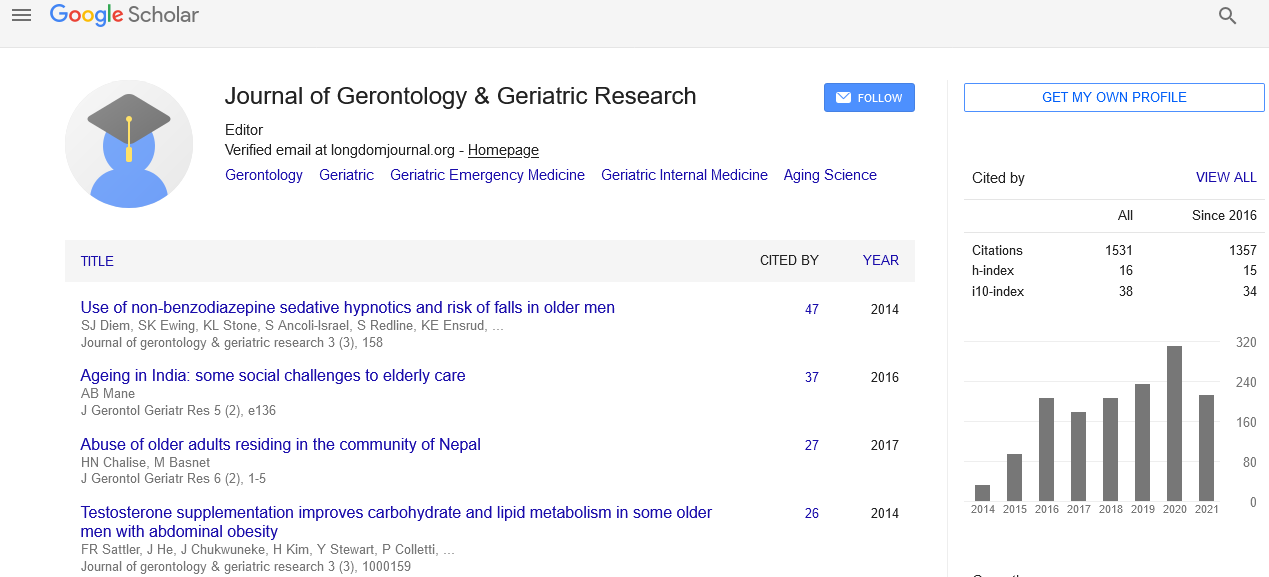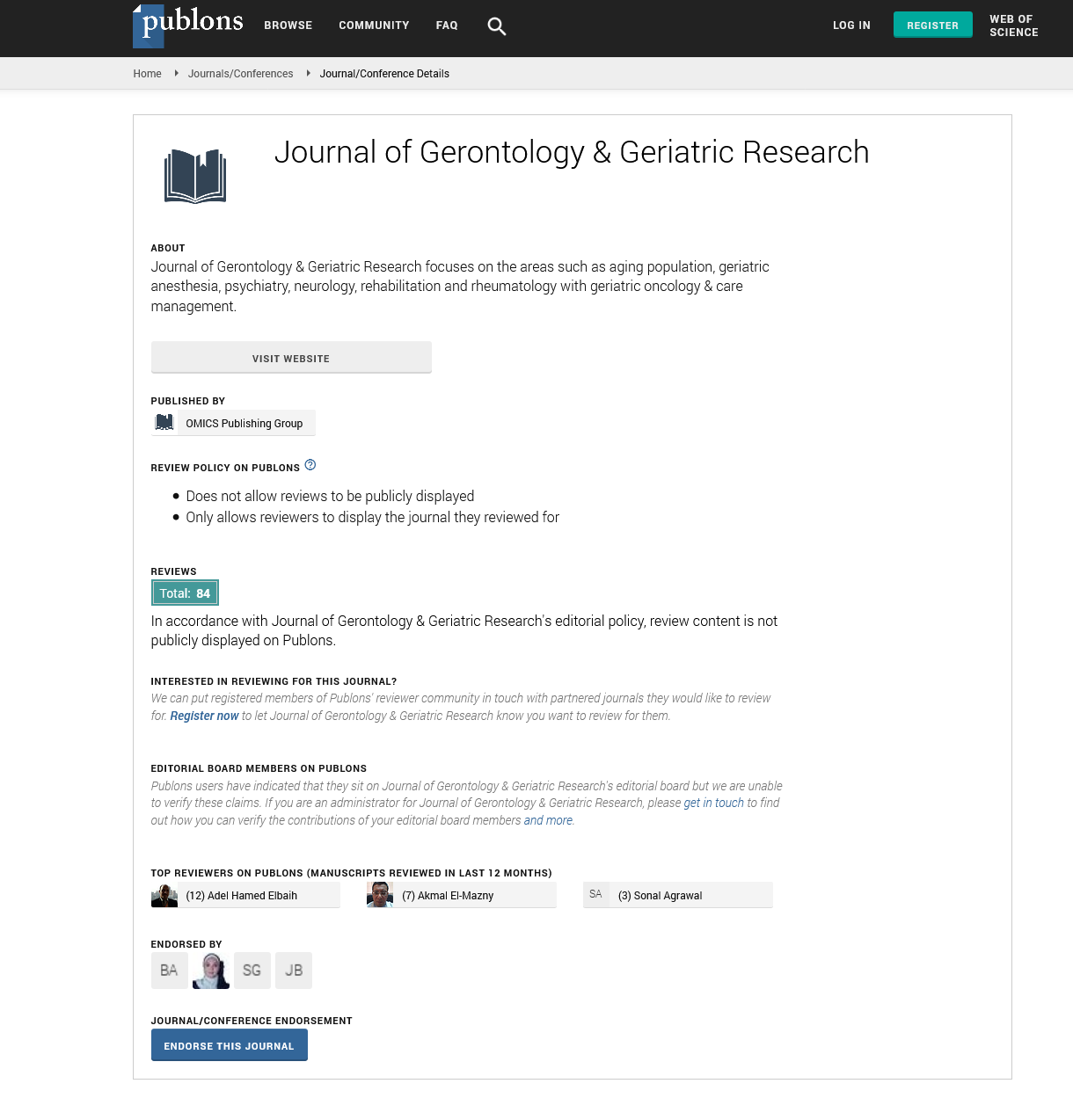PMC/PubMed Indexed Articles
Indexed In
- Open J Gate
- Genamics JournalSeek
- SafetyLit
- RefSeek
- Hamdard University
- EBSCO A-Z
- OCLC- WorldCat
- Publons
- Geneva Foundation for Medical Education and Research
- Euro Pub
- Google Scholar
Useful Links
Share This Page
Journal Flyer

Open Access Journals
- Agri and Aquaculture
- Biochemistry
- Bioinformatics & Systems Biology
- Business & Management
- Chemistry
- Clinical Sciences
- Engineering
- Food & Nutrition
- General Science
- Genetics & Molecular Biology
- Immunology & Microbiology
- Medical Sciences
- Neuroscience & Psychology
- Nursing & Health Care
- Pharmaceutical Sciences
Brief Report - (2021) Volume 10, Issue 6
Age-Related Cognitive and Obstacle Avoidance Performances
Sonia Puri*Received: 18-Jun-2021 Published: 28-Jun-2021, DOI: 10.35248/2167-7182.21.10.556
Brief Report
Higher-order neurological processes and cognition, which are involved in planning motions and responding to environmental changes, connect the motor and sensory systems. Recent research has shown that cognition plays a significant role in regulating locomotion in older adults, raising the possibility of a link between cognitive impairment and a higher risk of falling.
One of the most prevalent causes of falls is tripping when stepping over an obstruction, which can be exacerbated by cognitive impairment. Patients with Alzheimer's disease come into contact with barriers more frequently than healthy older persons, and this contact appears to be more common in the trailing leg. This could be due to the fact that stepping over an obstruction with the trailing limb is a hidden movement that is guided by working memory of the obstacle height. In experiments utilising quadrupedal animals that cannot perceive their hindlimb movements, Alzheimer's Disease model mice demonstrated a higher frequency of hindlimb contact during an obstacle avoidance task than non-Disease Alzheimer's model mice during an obstacle avoidance test. As a result, cognitive impairment, such as age-related memory loss in humans, may play a role in a failed trailing limb movement during the stepping-over motion, as seen by the much lower foot clearance than the leading limb. This assumption is plausible given that, due to the human body's anatomy, trailing limb movement during continuous obstacle avoidance is not seen in the peripheral visual field. However, it is uncertain whether memory impairment caused by age influences trailing limb movement (i.e., inadequate clearance) during obstacle avoidance.
Previous studies on age-related changes in obstacle avoidance have been contradicted (i.e., presence or absence of age-related changes in obstacle avoidance behaviour). Furthermore, nothing is known about the impact of age-related cognitive decline on human trailing limb movements during obstacle avoidance. However, as seen in Alzheimer's Disease model mice, relevant human research has suggested that age-related alterations may impede foot clearance of the trailing limb. For example, older adults showed slightly lower foot clearance of the trailing limb compared to young adults in a previous study with participants stepping over an obstacle with a lower height (10 percent of participants' leg length), whereas foot clearance of the leading limb did not change with age. This resulted in asymmetry in foot clearance, implying that ageing may influence trailing limb movement. Furthermore, older persons with a higher risk of falling, as evidenced by a history of falls and a deterioration in the lower extremities, had lower trailing limb clearance and, as a result, larger foot clearance asymmetries than low-risk older and young adults. In a previous study, high-risk older adults with lower extremity impairments also had a decline in cognitive functioning, implying that poor trailing limb movement could be the result of poor cognitive performance.
Whenever cognitive impairment has an impact on foot clearance during obstacle avoidance, it could also have an impact on lower limb behaviour during obstacle avoidance, such as toe-obstacle distance and heel-obstacle distance. Patients with Alzheimer's Disease land their leading foot substantially closer to the obstacle than older controls, according to a prior study. Despite the fact that the study implies that age-related cognitive decline may impact the control of foot-obstacle distance for obstacle avoidance in non-demented older adults, no study has yet investigated the cognitive correlates of such changes in limb control during obstacle avoidance.
Citation: Puri S (2021) Age-Related Cognitive and Obstacle Avoidance Performances. J Gerontol Geriatr Res. 10: 556.
Copyright: © 2021 Puri S. This is an open-access article distributed under the terms of the Creative Commons Attribution License, which permits unrestricted use, distribution, and reproduction in any medium, provided the original author and source are credited.


